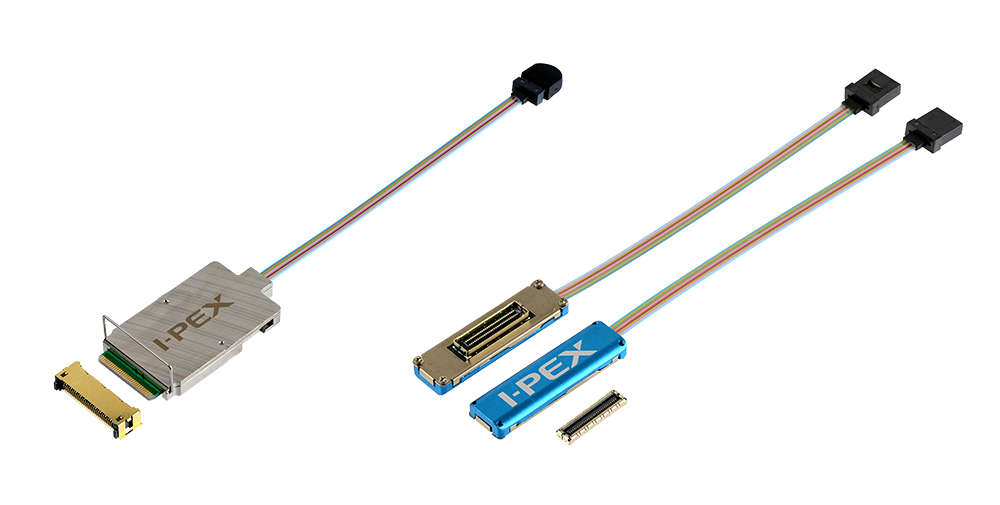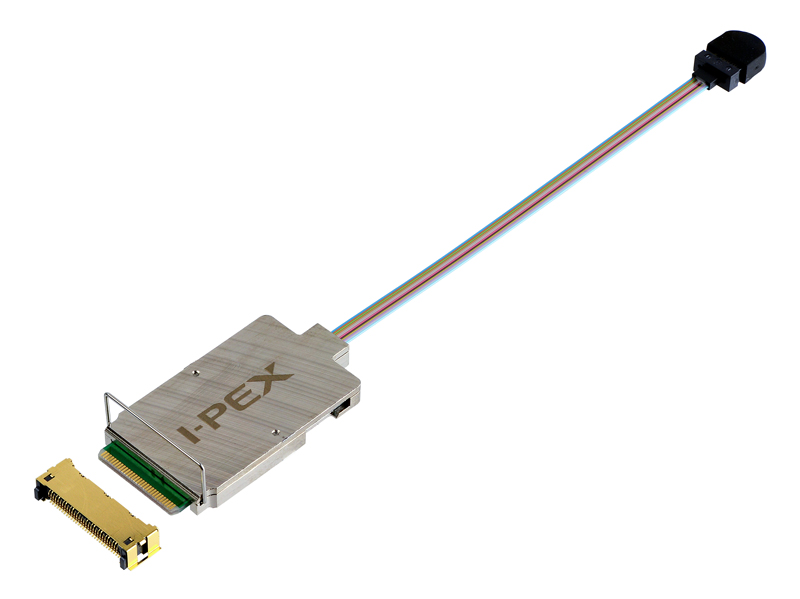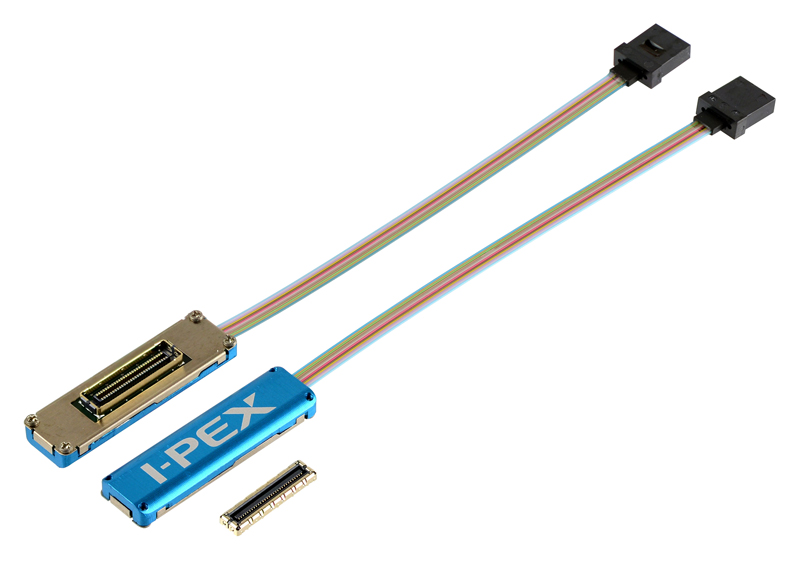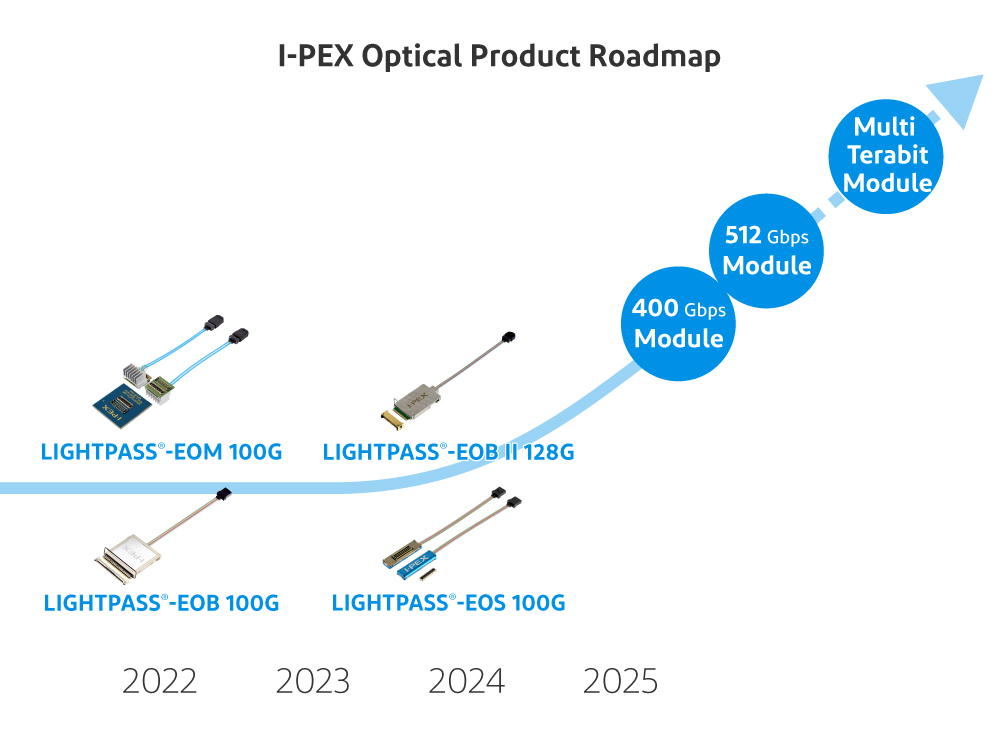Aug. 3, 2023

I-PEX Inc. (main office: Kyoto City, Kyoto Prefecture; President and CEO: Takaharu Tsuchiyama, Tokyo Stock Exchange Prime Number: 6640; hereinafter referred to as I-PEX) has developed the LIGHTPASS®-EOB II 128G, optimized for internal transmission inside base stations and other outdoor equipment necessary for internal transmission and high temperature operation inside NICs (network interface cards) and other information equipment, and the LIGHTPASS®-EOS 100G, optimized for robot arms and thin medical equipment such as endoscopes. These two products are part of the LIGHTPASS® Series active optical modules expected to be used for optical interconnection applications and IOWN* structures used for data centers and other uses.
Demo kits for evaluating these products will be available from September 2023, and mass production is scheduled to begin in the latter half of 2024. In addition, there will be demonstration units to be exhibited at ECOC Exhibition 2023, in the United Kingdom from October 2 to October 4, 2023.
- ※IOWN (Innovative Optical and Wireless Network) is a next-gen backbone network structure being promoted by the NTT Group that uses photoelectric fusion and optical communication technologies. I-PEX is taking part in the IOWN Global Forum as a General Member.
Development background
As the amount of communication over the Internet increases over the years due to the spread of AI, IoT, and 5G, it is becoming necessary to address high-speed transmission of large amounts of information using data center equipment that with post-5G and 6G information communication networks, as well as communication infrastructure, inspection equipment, high resolution monitors, cameras, and information terminal equipment.
Devices such as these currently use optical transmission to send signals outside at high speeds, perform photoelectric conversion using external modules, and are used to transmit electricity inside devices using mainly board wiring. Meanwhile, as data traffic increases, because insertion loss in conventional internal board wiring strongly limit transmission distances, and electric transmission capacities are reaching their limit, it is predicted that it will be difficult to complete them using internal electrical wiring, and electricity consumption, which continues to increase in proportion to transmission volume, has become a social issue.
 How LIGHTPASS® Series active optical modules can be used
How LIGHTPASS® Series active optical modules can be usedThe LIGHTPASS® Series allows the electric transmission wiring inside these devices to be replaced with those for optical transmission and perform photoelectric conversion closer to the processor, minimizing the distance from the electrical wiring on the board, and help reduce transmission loss and energy conservation. It helps make photoelectric fusion in next-gen data centers and high-speed communication devices a reality.
Features of the LIGHTPASS®-EOB II 128G
 LIGHTPASS®-EOB II 128G
LIGHTPASS®-EOB II 128GThe LIGHTPASS®-EOB II 128G has a different connector shape than the LIGHTPASS®-EOB 100G, with a width of 18.6 mm that allows it to be mounted to M.2 and other cards. It has switched to a 3.3 V single power supply, and the PCIe Gen 5 signals is also supported for increased the transmission speed to 128 Gbps (32 Gbps NRZ x 4ch).
It has high heat dissipation and is expected to be used for internal transmissions in base stations outdoor devices that require high temperature operation inside NICs (network interface cards) and other information equipment and wiring and other applications inside aircraft, which are facing demand to become lighter.
Features of the LIGHTPASS®-EOS 100G
 LIGHTPASS®-EOS 100G
LIGHTPASS®-EOS 100GThe LIGHTPASS®-EOS 100G is smaller thanks to its stick shape. Similarly to the LIGHTPASS®-EOB II 128G, it has switched to a 3.3 V single power supply, and there are plans to make it ready for an autoclave sterilization.
It can be installed in robot arms with restraints on their mounting parts, thin medical equipment such as endoscopes, and industrial machinery that needs to mount many parts.
About the LIGHTPASS® Series
The LIGHTPASS® Series is a series of multi-mode active optical modules equipped with IOCoreTM, a silicon photonics IC developed by AIO Core Co., Ltd. (main office: Bunkyo City, Tokyo Metropolis, President and CEO: Hidetaka Fukuda), that is capable of bi-directional optical communication.
I-PEX has developed the LIGHTPASS®-EOB 100G and LIGHTPASS®-EOM 100G active optical module products and has available evaluation demo kits. Now, I-PEX has added to its product lineup the LIGHTPASS®-EOB II 128G and LIGHTPASS®-EOS 100G, which have reliable longevity under hot environments, and is developing a system to make internal optical transmission a reality within a wide range of applications including servers.
 Active optical module product development roadmap
Active optical module product development roadmapProduct specifications
| Product Name | LIGHTPASS®-EOM 100G | LIGHTPASS®-EOB 100G | LIGHTPASS®-EOB II 128G | LIGHTPASS®-EOS 100G |
|---|---|---|---|---|
| Size (W, D, H) (mm) | 14.0 x 12.0 x 8.6 | 29.75 x 29.01 x 2.3 | 18.6 x 36.3 x 3.8 | 8.4 x 34.8 x 4.6 |
| Transmission capacity | 100 Gbps (25 Gbps x 4 ch) |
100 Gbps (25 Gbps x 4 ch) |
128 Gbps (32 Gbps x 4 ch) |
100 Gbps (25 Gbps x 4 ch) |
| Power supply (V) |
0.9, 1.0, 3.3 | 0.9, 1.0, 3.3 | 3.3 | 3.3 |
| Operation case temperature range (°C) |
-40 ~ 85 | -40 ~ 85 (105) | -40 ~ 85 (105) | -40 ~ 85 |
| Microcontroller unit | × | 〇 | 〇 | 〇 |
| Mechanical lock | × | 〇 | 〇 | × |
About AIO Core Co., Ltd. and IOCoreTM
AIO Core Co., Ltd. is a corporation split off from the Photonics Electronics Technology Research Association (PETRA) that was established with some of its intellectual property rights and a part of technologies. PETRA was consigned by the New Energy and Industrial Technology Development Organization (NEDO) to develop these products.
The IOCoreTM developed by AIO Core Co., Ltd. is a 5 mm square optical transceiver chip fabricated from “silicon photonics technology,” which is used to form optical devices on silicon circuit boards. They have a transmission speed of up to 32 Gbps per channel and capable of bi-directional optical communication of up to 128 Gbps with 4 channels.
